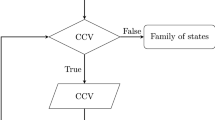Abstract
One of the main problems of quantum information theory is developing the separability criterion which is both necessary and sufficient in nature. Positive partial transposition test (PPT) is one such criterion which is both necessary and sufficient for \(2\times 2\) and \(2\times 3\) systems but not otherwise. We express this strong PPT criterion for a system of 2-qubit symmetric states in terms of the well-known Fano statistical tensor parameters and prove that a large set of separable symmetric states are characterised by real statistical tensor parameters only. The physical importance of these states are brought out by employing trivariate representation of density matrix wherein the components of \({\mathbf{J}}\), namely \(J_{x}\), \(J_{y}\), \(J_{z}\) are considered to be the three variates. We prove that this set of separable states is characterised by the vanishing average expectation value of \(J_{y}\) and its covariance with \(J_{x}\) and \(J_{z}\). This allows us to identify a symmetric separable state easily. We illustrate our criterion using 2-qubit system as an example.
Similar content being viewed by others
References
M B Plenio and S Virmani, Quantum Inf. Comput. 103, 1 (2007)
R Horodecki, P Horodecki, M Horodecki and K Horodecki, Rev. Mod. Phys. 81, 865 (2009)
L Gurvits, Proceedings of the 55th Annual ACM Symposium on Theory of Computing (2003) Vol. 10
M Lewenstein, B Kraus, I J Cirac and P Horodecki, Phys. Rev. A 62, 052310 (2000)
H Haeffner, W Haensel, C F Roos, J Benhelm, D Chekalkar, M Chwalla, T Koerber, U D Rapol, M Riebe, P O Schmidt, C Becher, O Guehne, W Duer and R Blatt, Nature 438, 643 (2005)
A Peres, Phys. Rev. Lett. 77, 1413 (1996)
A Acin, D Drub, M Lewenstein and A Sanpera, Phys. Rev. Lett. 87, 040401 (2001)
T Eggeling and R F Werner, Phys. Rev. A 63, 042111 (2001)
C Eltscka, A Osterloh, J Siewert and A Uhlmann, New J. Phys. 10, 043014 (2008)
O Guhne and M Seevinck, New J. Phys. 12, 053002 (2010)
E Jung, M R Hwang, D K Park and J W Son, Phys. Rev. A 79, 024306 (2009)
M Huber, F Mintert, A Gabriel and B C Hiesmayr, Phys. Rev. Lett. 104, 210501 (2010)
W K Wootters, Phys. Rev. Lett. 80, 2245 (1998)
M Horodecki, P Horodecki and R Horodecki, Phys. Lett. A 223, 1 (1996)
M Horodecki, P Horodecki and R Horodecki, Phys. Rev. Lett. 80, 5239 (1998)
F Bohnet-Waldraff, D Braun and O Giraud, Phys. Rev. A 94, 042343 (2016)
T S Mahesh, C S Sudheer Kumar and T Bhosale Udaysinh, Quantum correlations in NMR systems (Springer International Publishing, 2017)
U Fano, Phys. Rev. 90, 577 (1953)
U Fano, Rev. Mod. Phys. 29, 74 (1957)
U Fano, Rev. Mod. Phys. 55, 855 (1983)
G Ramachandran, A R Usha Devi, P Devi and Swarnamala Sirsi, Found. Phys. 26, 401 (1996)
G Racah, Group theory and spectroscopy, CERN report, 61 (1961)
M E Rose, Elementary theory of angular momentum (John Wiley, 1957)
A R Usha Devi, Swarnamala Sirsi, G Ramachandran and P Devi, Int. J. Mod. Phys. A 12, 2779 (1997)
Author information
Authors and Affiliations
Corresponding author
Rights and permissions
About this article
Cite this article
Suma, S.P., Sirsi, S. Trivariate analysis of two qubit symmetric separable state. Pramana - J Phys 91, 24 (2018). https://doi.org/10.1007/s12043-018-1598-x
Received:
Revised:
Accepted:
Published:
DOI: https://doi.org/10.1007/s12043-018-1598-x




